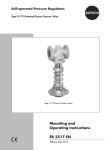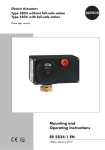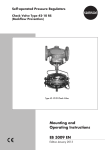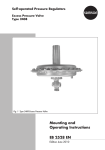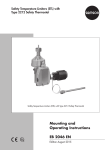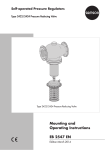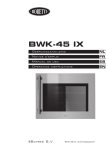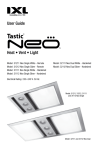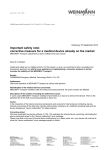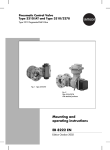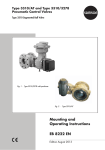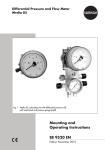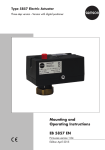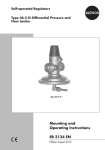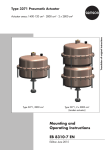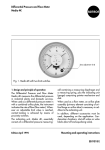Download Mounting and Operating Instructions EB 2512 EN
Transcript
Self-operated Pressure Regulators Type 41-23 Universal Pressure Reducing Valve Type 41-23 Pressure Reducing Valve Mounting and Operating Instructions EB 2512 EN Edition July 2015 Definition of signal words DANGER! Hazardous situations which, if not avoided, will result in death or serious injury WARNING! Hazardous situations which, if not avoided, could result in death or serious injury 2 NOTICE Property damage message or malfunction Note: Additional information Tip: Recommended action EB 2512 EN Contents 1 General safety instructions..............................................................................4 2 Process medium and scope of application........................................................5 2.1 Transportation and storage..............................................................................5 3 Design and principle of operation...................................................................5 4 Installation.....................................................................................................6 4.1Assembly.......................................................................................................6 4.2 Mounting position...........................................................................................8 4.3 Control line, compensation chamber and needle valve.......................................9 4.4 Strainer (filter)..............................................................................................10 4.5 Shut-off valve................................................................................................10 4.6 Pressure gauge.............................................................................................10 5 Operation....................................................................................................11 5.1Start-up........................................................................................................11 5.2 Adjusting the set point...................................................................................11 5.3Decommissioning..........................................................................................12 6 Cleaning and maintenance...........................................................................13 6.1 Replacing the operating diaphragm...............................................................13 7 Customer inquiries.......................................................................................15 8 Dimensions..................................................................................................15 9 Nameplate...................................................................................................17 10 Technical data..............................................................................................18 EB 2512 EN 3 General safety instructions 1 General safety instructions −− The regulator is to be mounted, started up or serviced by fully trained and qualified personnel only; the accepted industry codes and practices are to be observed. Make sure employees or third persons are not exposed to any danger. −− All safety instructions and warnings given in these mounting and operating instructions, particularly those concerning installation, start-up and maintenance, must be strictly observed. −− According to these mounting and operating instructions, trained personnel refers to individuals who are able to judge the work they are assigned to and recognize possible dangers due to their specialized training, their knowledge and experience as well as their knowledge of the applicable standards. −− The regulators comply with the requirements of the European Pressure Equipment Directive 2014/68/EU. Devices with a CE marking have a declaration of conformity, which includes information about the applied conformity assessment procedure. This declaration of conformity can be provided on request. −− To ensure appropriate use, only use the regulator in applications where the operating pressure and temperatures do not exceed the specifications used for sizing the regulator at the ordering stage. −− The manufacturer does not assume any responsibility for damage caused by external forces or any other external factors. −− Any hazards that could be caused in the regulator by the process medium, operating pressure or by moving parts are to be prevented by taking appropriate precautions. −− Proper transport, storage, installation, operation and maintenance are assumed. 4 EB 2512 EN Process medium and scope of application 2 Process medium and scope of application Pressure regulators for set points from 0.05 to 28 bar · Valve nominal sizes DN 15 to 100 Nominal pressure PN 16 to 40 · Suitable for liquids, gases and vapors up to 350 °C The valve closes when the downstream pressure rises. NOTICE The Type 41-23 Pressure Reducing Valve is not a safety valve. If necessary, a suitable overpressure protection must be installed on site in the plant section. 2.1 Transportation and storage The regulator must be carefully handled, transported and stored. Protect the regulator against adverse influences, such as dirt, moisture or frost, during storage and transportation. When regulators are too heavy to be lifted by hand, fasten the lifting sling at a suitable place on the valve body. NOTICE Do not attach any lifting equipment, slings or supports to mounting parts, such as the adjusting screw or control line. 3 Design and principle of operation See Fig. 1 on page 7. The Type 41-23 Pressure Reducing Valve consists of a Type 2412 Closing Valve and a Type 2413 Actuator. The valve and actuator are delivered separately and must be assembled according to the instructions in section 4.1. The pressure reducing valve is used to maintain the pressure downstream of the valve to an adjusted set point. The process medium flows through the valve between seat (2) and plug (3) in the direction indicated by the arrow on the body. The position of the valve plug determines the flow rate and the pressure ratio across the valve. The plug stem is sealed by a frictionless bellows EB 2512 EN 5 Installation (5.1). The downstream pressure p2 is transmitted through the compensation chamber (18) and control line (17) to the operating diaphragm (12) where it is converted into a positioning force. For actuator versions with a bellows, the pressure is transmitted to the operating bellows (12.1). The positioning force is used to move the valve plug according to the force of the positioning springs (7). The spring force is adjustable at the set point adjuster (6). Valves with KVS 4 and higher feature a balancing bellows (4). The upstream pressure acts on the outside of the bellows and the downstream pressure on the inside of the bellows. As a result, the forces produced by the upstream and downstream pressures acting on the plug are balanced. Depending on the valve and actuator used, the regulator can be upgraded to create a pressure reducing valve for low flow rates, a steam pressure reducing valve or a pressure reducing valve with increased safety. 4 Installation 4.1 Assembly See Fig. 1 on page 7. Valve and actuator can be assembled before or after the valve has been installed in the pipeline. Push the diaphragm actuator (10) with actuator stem (11) through the hole in the crossbeam (8) onto the spigots of the bellows (5.1). Align it and fasten with nuts (width 6 across flats 16, 9) onto the valve flange (approx. 25 Nm). For metal bellows actuators in DN 15 to 50, remove the crossbeam (8) from the valve. Push the actuator stem (11) onto the spigots of the bellows (5.1). Align the pillars (8.1) and fasten with nuts (width across flats 24, 8.2) to the actuator (max. 60 Nm). For metal bellows actuators in DN 65 to 100, remove the crossbeam (8) from the valve and unscrew the pillars (8.1). Screw the pillars into the threaded holes (8.3) of the actuator flange as far as they will go. Push the actuator with actuator stem (11) onto the spigots of the bellows (5.1). Fasten the pillars with nuts (width across flats 24, 8.2) onto the valve flange (max. 60 Nm). 1 2 3 4 5 5.1 6 7 8 8.1 8.2 8.3 9 10 11 12 12.1 13 14 15 16 17 18 19 20 Valve body Seat Plug Balancing bellows Plug stem Bellows Set point adjuster Positioning springs Crossbeam Pillar Nuts for pillar Threaded holes Fastening nuts Diaphragm actuator Actuator stem Operating diaphragm Operating bellows Diaphragm plate Nut Nuts and bolts Control line connection G ¼ (for steam including screw joint with restriction) Control line installed on site (control line kit available for tapping the pressure directly at the valve body, see T 2595) Compensation chamber Filler plug Anti-rotation clip EB 2512 EN Installation 1 2 Type 2412 Valve 19 3 8.2 18 4 8.2 5 6 7 5.1 8.1 12.1 17 DN 15 to 50 20 Type 2413 Diaphragm Actuator 9 8 8.2 10 Type 2413 Actuator with metal bellows for 2 to 6 bar, 5 to 10 bar, 20 to 28 bar and 10 to 22 bar 8.3 15 16 11 12 13 14 Table 1: Assignment of compensation chamber (18) to regulator Actuator area A in cm² Item number ∙ Compensation chamber DN 15 to 50 DN 65 to 250 640 1190-8789 1190-8790 320 1190-8788 1190-8789 160/80/40 Metal bellows actuator for DN 65 to 100 1190-8788 Fig. 1: Functional diagram EB 2512 EN 7 Installation 4.2 Mounting position Standard mounting position for gases, liquids and steam Not for millibar pressure regulator NOTICE Protect the regulator from icing up when controlling media that can freeze. Remove the regulator from the pipeline when the plant is shut down if the regulator is not installed areas free from frost. Alternative mounting position for gases and liquids at medium temperature up to 80 °C Prescribed mounting position for millibar pressure regulators Flush the pipeline thoroughly before installing the regulator to ensure that any sealing parts, weld spatter and other impurities carried along by the process medium do not impair the proper functioning of the valve, above all the tight shut-off. NOTICE Install a strainer (e.g. SAMSON Type 2) upstream of the regulator. Install the pressure reducing valve in horizontal pipelines. On installing the valve, make sure the direction of flow corresponds with the arrow on the body. For media with a tendency to condensate, install the pipeline with a slight downward slope on both sides so that the condensate can drain properly. If the pipeline upstream and downstream of the valve run vertically upwards, an automatic water drainage (e.g. SAMSON Type 13 E Steam Trap) is required. Choose a place of installation that allows you to freely access the regulator even after the entire plant has been completed. The regulator must be installed free of stress. If necessary, support the pipe near the connecting flanges. 8 Not for steam Not permissible! 1) On request: Permissible for regulators with fixed plug stem guide plus with medium temperature up to 80 °C. Not for steam. 1) Fig. 2: Mounting position NOTICE Do not attach supports directly to the valve or actuator. If a bypass line is to be used, it must be connected downstream of the pressure tapping point. Install a shut-off valve in the bypass line. Note: Do not install any instruments (e.g. temperature regulators or shut-off valves) that restrict the cross-section of the pipe between the pressure tapping point and the valve. EB 2512 EN Installation 4.3 Control line, compensation chamber and needle valve Control line · A control line must be provided at the site of installation, e.g. a 3/8“ pipe for steam or an 8 x 1 or 6 x 1 mm pipe for air/water. Connect the control line to the downstream line (p2) at least one meter away from the valve outlet (Fig. 3.1). If a manifold is located downstream of the pressure reducing valve (Fig. 3.2), connect the valve to the manifold, even if it is several meters away. If the downstream line behind the valve is ex- 1 2 3 5 4 Control line kit · A control line kit for tapping pressure directly at the valve body is available as an accessories part from SAMSON. Compensation chamber ∙ See Table 1 on page 7. A compensation chamber is required for liquids above 150 °C as well as for steam. 7 NOTICE Always install the millibar pressure regulator upright with the actuator on top. 3.1 Control line connection 1 2 3 4 6 tended by a conical expansion piece, connect the control line in the expanded section of the line. Weld the control line at the side in the middle of the pipe, inclining at a ratio of approximately 1:10 up to the compensation chamber. Shut-off valve Upstream pressure gauge Strainer Compensation chamber 5 6 7 8 Pressure reducing valve Downstream pressure gauge Shut-off valve Steam trap Min. pipe diameter ½“ 3.3 Control line connection below the middle of the flange 6 1 2 3 5 3.2 Control line connection in manifold Fig. 3: Examples of installation with steam EB 2512 EN 8 Additional condensate head 3.4 Connection above the middle of the flange 9 Installation The mounting position of the compensation chamber is indicated by an adhesive label on the chamber itself as well as by an arrow and the word "top" stamped on the top of the chamber. This mounting position must be adhered to; otherwise the safe functioning of the pressure reducing valve cannot be guaranteed. Weld the line coming from the pressure tapping point to the 3/8“ pipe socket on the chamber. Install the compensation chamber at the highest point of the pipeline. Consequently, the control line between compensation chamber and actuator must also be installed with a downward slope. In this case, use a 3/8“ pipe with screw fittings. If the control line connection is located below the middle of the valve outlet flange, arrange the compensation chamber at the same level as the outlet flange (Fig. 3.3). In this case, use a pipe which is at least ½“ in size for the control line from the tapping point to the compensation chamber. If the control line is connected above the middle of the valve outlet flange, install the compensation chamber at the same level as the downstream pressure tapping point (Fig. 3.4). The additional pressure of the condensate head must be compensated for by adjusting the set point to a higher value. 4.4 Strainer (filter) Install the strainer upstream of the pressure reducing valve. The direction of flow must correspond to the arrow on the body. The filter element must be installed to hang downwards or sideways for applications with steam. Remember to leave enough space to remove the filter element. 4.5 Shut-off valve Install a hand-operated shut-off valve both upstream of the strainer and downstream of the regulator. This allows the plant to be shut down for cleaning and maintenance, and when the plant is not used for longer periods of time. 4.6 Pressure gauge Install a pressure gauge both upstream and downstream of the regulator to monitor the pressures prevailing in the plant. Install the pressure gauge on the downstream side behind the downstream pressure tapping point (not between the tapping point and the valve). Needle valve · If the regulator tends to hunt, we recommend installing a needle valve at the control line connection (16) in addition to the standard SAMSON screw joint with restriction. 10 EB 2512 EN Operation 5 Operation 5.1 Start-up See Fig. 1 on page 7. First start up the regulator after mounting all parts. Make sure the control line is open and correctly connected. Fill the plant slowly with the process medium. Avoid pressure surges. Open the shut-off valves first on the upstream pressure side. Afterwards, open all the valves on the consumer side (downstream of the regulator). NOTICE The pressure at the actuator must not exceed the permissible pressure on testing the pressure of the plant (see section 10). If necessary, detach the control line and seal the openings with end plugs. Alternatively, install a shut-off valve in the control line. Make sure that the pressure rises simultaneously upstream and downstream of the regulator to avoid damaging the balancing bellows. Regulation of liquids To start up the pressure reducing valve, open shut-off valves slowly. For temperatures above 150 °C, first fill the compensation chamber with the process medium. 5.2 Adjusting the set point See Fig. 1 on page 7. The required downstream pressure is set by turning the set point adjuster (6) using an open-end wrench (up to DN 50 with width across flats SW 19 and for DN 65 and larger with SW 24). The set point of the stainless steel regulator must be adjusted using the rod included. Turn clockwise to increase the downstream pressure and turn counterclockwise to reduce it. The pressure gauge located on the downstream pressure side allows the adjusted set point to be monitored. An adjustment of the set point can also be made by turning the set point adjuster until the distance x (see Fig. 4) is reached. Unscrew filler plug (19) on the compensation chamber. Use the included plastic funnel or a jug to pour in water until it starts to overflow. Screw the filler plug back in and tighten it. The pressure reducing valve is now ready for operation. Open the hand-operated shut-off valves slowly to prevent water hammer. Set point adjuster (6) X Regulation of steam Fig. 4: Set point adjustment with dimension x EB 2512 EN 11 Installation Table 2 lists the set points and their assigned distance x for the regulators and their various set point ranges. Table 2: Set point adjustment – Dimension x Set point range Set point 8 to 16 bar Nominal size DN 15 to 25 32 to 50 x = 89 mm x = 106 mm x = 133 mm 12 bar x = 97 mm x = 117 mm x = 150 mm 14 bar x = 104 mm x = 128 mm x = 168 mm 10 bar 65 to 100 Set point 4.5 to 10 bar Set point Note: Note that only a rough set point adjustment is performed by turning the set point adjustment until the distance x is reached. The special properties of the process medium and plant are not taken into account in this case. Check the pressure at the pressure gauge downstream of the regulator for a precise set point adjustment. 5.9 bar x = 85 mm x = 100 mm x = 131 mm 7.3 bar x = 93 mm x = 112 mm x = 152 mm 8.6 bar x = 101 mm x = 123 mm x = 172 mm 5.3 Decommissioning 2.8 bar x = 83 mm x = 97 mm 3.5 bar x = 92 mm x = 110 mm x = 170 mm 4.3 bar x = 100 mm x = 122 mm x = 184 mm Close first the shut-off valve on the upstream side of the valve and then on the downstream side of the valve. 2 to 5 bar x = 126 mm 0.8 to 2.5 bar Set point 1.2 bar x = 79 mm x = 92 mm 1.7 bar x = 89 mm x = 106 mm x = 142 mm x = 117 mm 2.1 bar x = 99 mm x = 121 mm x = 167 mm 0.45 bar x = 71 mm x = 81 mm x = 98 mm 0.70 bar x = 83 mm x = 98 mm x = 127 mm 1.0 bar x = 95 mm x = 117 mm x = 157 mm 0.23 bar x = 71 mm x = 81 mm x = 98 mm 0.35 bar x = 83 mm x = 98 mm x = 127 mm 0.48 bar x = 95 mm x = 115 mm x = 157 mm Set point 0.2 to 1.2 bar Set point 0.1 to 0.6 bar Set point 0.05 to 0.25 bar 0.10 bar x = 70 mm x = 80 mm x = 92 mm 0.15 bar x = 81 mm x = 95 mm x = 116 mm 0.20 bar x = 91 mm x = 110 mm x = 139 mm 12 EB 2512 EN Cleaning and maintenance 6 Cleaning and maintenance See Fig. 1 on page 7. The regulator does not require any maintenance. Nevertheless, it is subject to natural wear, particularly at the seat, plug and operating diaphragm. Depending on the operating conditions, check the regulator at regular intervals to avoid possible malfunctions. Details on faults and how to remedy them can be found in Table 3. WARNING! Before performing any work on the regulator, make sure the relevant plant section has been depressurized and, depending on the process medium, drained as well. We recommend removing the valve from the pipeline. When used at high temperatures, allow the plant section to cool down to ambient temperature. Disconnect or shut off the control line to prevent the risk of moving regulator parts. As valves are not free of cavities, remember that residual process medium might still be contained in the valve. NOTICE Make absolutely sure that no torque is applied to the bellows seal (5.1) during assembly or disassembly. Otherwise, the metal bellows will be destroyed. On disassembling the valve, push the anti-rotation clip (20 in Fig. 1) to "entriegelt" (unlock). Push it back again to "verriegelt" (lock) on reassembly. See also the note on the crossbeam (8). 6.1 Replacing the operating diaphragm If the downstream pressure deviates considerably from the set point, check if the diaphragm is leaking and, if necessary, replace it as follows. −− Shut down the plant by slowly closing the shut-off valves. Depressurize the relevant section of the pipeline and, if necessary, drain it as well. −− Unscrew the control line (17) and clean it. −− Loosen the bolts (15) at the actuator and remove the casing. −− Unscrew the nut (14) and lift off the diaphragm plate (13). −− Replace the operating diaphragm (12) with a new one. −− Proceed in the reverse order to reassemble the regulator. For start-up, proceed as described in section 5.1. EB 2512 EN 13 Cleaning and maintenance Table 3: Troubleshooting Malfunction Pressure exceeds the adjusted set point. Pressure drops below the adjusted set point. Jerky control response Slow control response Downstream pressure hunts Loud noises 14 Possible reasons Recommended action Insufficient pressure pulses on the operating diaphragm. Clean the control line and the screw joint with restriction. Seat and plug worn down by deposits or foreign particles. Disassemble the regulator and replace damaged parts. Pressure tapped at the wrong place. Reconnect control lines at a different place. Do not tap pressure at pipe bends or necks. With steam: compensation chamber in the wrong position or too small. Reconnect chamber at a different place or replace it (see Table 1 and section 4.3). Control response too slow. Install larger screw joint at the diaphragm actuator. Foreign particles blocking the plug Disassemble the regulator and replace damaged parts. Valve installed against the flow; see arrow on body. Check direction of flow. Install valve correctly. Pressure tapped at the wrong place. Reconnect control line at a different place. Valve or KVS coefficient too small Check valve sizing. Install larger valve, if necessary. Control response too slow. Install larger screw joint at the diaphragm actuator. With steam: compensation chamber in the wrong position or too small. Reconnect chamber at a different place or replace it (see Table 1 and section 4.3). Foreign particles blocking the plug. Disassemble the regulator and replace damaged parts. Increased friction, e.g. due to foreign particles between seat and plug. Remove foreign particles. Replace damaged parts. Restriction in the screw joint of the actuator dirty or too small. Clean screw joint or install larger screw joint. Dirt in the control line. Clean the control line. Valve too large Check valve sizing. Select smaller KVS coefficient, if necessary. Restriction in the screw joint of the actuator too large. Install smaller screw joint. Pressure tapped at the wrong place. Select better place for pressure tapping. High flow velocity, cavitation. Check sizing. Install flow divider with gases and steam. EB 2512 EN Customer inquiries 7 Customer inquiries Contact SAMSON's After-sales Service department for support when malfunctions or defects arise. E-mail address: [email protected] The addresses of SAMSON AG, its subsidiaries, representatives and service facilities worldwide can be found on the SAMSON website (u www.samson.de), in all SAMSON product catalogs or on the back of these Mounting and Operating Instructions. To assist diagnosis and in case of an unclear mounting situation, specify the following details: −− Type and nominal size of the valve −− Model number with index −− Upstream and downstream pressure −− Temperature and process medium −− Min. and max. flow rate −− Is a strainer installed? −− Installation drawing showing the exact location of the regulator and all the additionally installed components (shut-off valves, pressure gauge, etc.) 8 Dimensions L H3 Type 2412 Valve Type 41-23 Universal Pressure Reducing Valve H1 H H Type 2413 Metal Bellows Actuator Type 2413 Diaphragm Actuator ØD Fig. 5: Dimensions EB 2512 EN 15 Customer inquiries Table 4: Dimensions in mm and weights Pressure reducing valve Valve size DN Length L 15 20 25 32 Type 41-23 40 50 65 80 100 130 150 160 180 200 230 290 310 350 70 – 98 – Height H1 Height H3 335 Forged steel 53 390 – Other materials 55 92 510 525 128 – 72 100 120 500 620 635 620 635 600 620 605 620 585 600 585 600 585 600 Set point ranges Standard version with rolling diaphragm Height H 0.05 to 0.25 bar Actuator 445 0.1 to 0.6 bar Height H 445 0.2 to 1.2 bar Height H 0.8 to 2.5 bar Height H 2 to 5 bar Height H 4.5 to 10 bar Height H 8 to 16 bar Height H ØD = 380 mm, A = 640 cm² 500 Actuator ØD = 380 mm, A = 640 cm² 430 480 Actuator ØD = 285 mm, A = 320 cm² 430 485 Actuator ØD = 225 mm, A = 160 cm² 410 465 Actuator ØD = 170 mm, A = 80 cm² 410 465 Actuator ØD = 170 mm, A = 40 cm² 410 465 Actuator ØD = 170 mm, A = 40 cm² Set point ranges Weight for version with rolling diaphragm 0.05 to 0.6 bar 0.2 to 2.5 bar 2 to 16 bar Weight, based on cast iron 1), approx. kg 22.5 23.5 29.5 31.5 35 51 58 67 16 18 23.5 25.5 29 45 52 61 12 13 18.5 21 24 40 47 56 Set point ranges Special version with metal bellows actuator 2 to 6 bar Height H 5 to 10 bar Height H 10 to 22 bar Height H 20 to 28 bar Height H 550 605 Actuator 725 740 725 740 710 725 710 725 A = 62 cm² 550 605 Actuator A = 62 cm² 535 590 Actuator A = 33 cm² 535 590 Actuator A = 33 cm² Weight for version with metal bellows actuator 23.5 25.5 29 48 56 66 A = 62 cm² iron 1), approx. kg 20.9 21.5 22 27.5 1) +10 % for cast steel, spheroidal graphite iron and forged steel 29.5 33 54 65 75 A = 33 cm² 16 Based on cast 16.5 17.9 18 EB 2512 EN Nameplate 9 Nameplate Nameplates are attached to the valve and the actuator. DIN version Valve nameplate 3 2 4 1 SAMSON 5 Kvs No ∅p PN DN 8 7 bar T 9 ˚C Made in Germany 11 10 12 DIN version 1 Valve type 2 Model number with index 3 Configuration ID (Var.-ID) 4 Order number or date 5 KVS coefficient 7 1 3 2 4 SAMSON 5 No psi T ∅p 7 8 Size Cl Cv ˚F Made in Germany 10 9 12 11 ANSI version Valve size 9 Nominal pressure 10 Perm. differential pressure 11 Perm. temperature 12 Body material ANSI version 5 Nominal size 7 Spring force 8 Perm. differential pressure 9 Perm. temperature (°F) 10 Body material 11 CV coefficient (KVS x 1.17) 12 3 SAMSON bar bar psi 6 Var.-ID psi DN 9 ANSI Class (pressure rating) DIN/ANSI version Actuator nameplate 2 Spring force 8 1 4 No cm² bar 7 sq.in size psi 7 10 9 2002 0062 1 Actuator area (DIN/ANSI) 2 Type 3 Configuration ID (Var.-ID) 4 ID number 6 Max. perm. pressure (pexceed) above the set point adjusted at the actuator (DIN/ANSI) 7 Valve size (DIN/ANSI) 9 Set point range (DIN/ANSI) 10 Diaphragm material Made in Germany Fig. 6: Nameplates EB 2512 EN 17 Technical data 10Technical data Table 5: Technical data · All pressures in bar (gauge) Valve Type 2412 Nominal pressure PN 16, 25 or 40 Nominal size DN 15 to 50 DN 65 to 80 25 bar 20 bar Max. permissible differential pressure ∆p Max. permissible temperature DN 100 16 bar See pressure-temperature diagram in u T 2500 Valve plug Metal seal: max. 350 °C · PTFE soft seal: max. 220 °C · EPDM or FPM soft seal: max. 150 °C · NBR soft seal: max. 80 °C 1) Leakage class according to IEC 60534‑4 Metal seal: leakage class I (≤0.05 % of KVS coefficient) Soft seal: leakage class IV (≤0.01 % of KVS coefficient) Diaphragm actuator Type 2413 Set point ranges 0.05 to 0.25 bar · 0.1 to 0.6 bar · 0.2 to 1.2 bar · 0.8 to 2.5 bar 3) 2 to 5 bar · 4.5 to 10 bar · 8 to 16 bar Max. permissible temperature Gases 350 °C, however, max. 80 °C at the actuator 1) Liquids 150 °C, with compensation chamber max. 350 °C Steam with compensation chamber max. 350 °C Metal bellows actuator Type 2413 Effective area Set point ranges 33 cm² 62 cm² 10 to 22 bar 20 to 28 bar 2 to 6 bar 2) 5 to 10 bar Set point spring 8000 N With oxygen: max. 60 °C · Set point spring: 4400 N 1) 2) Version with actuator with two diaphragms: 1 to 2.5 bar 3) Max. permissible pressure at actuator Set point range · Actuator with rolling diaphragm 0.05 to 0.25 bar 0.6 bar 0.1 to 0.6 bar 0.2 to 1.2 bar 0.8 to 2.5 bar 2 to 5 bar 4.5 to 10 bar 8 to 16 bar Max. permissible pressure (pexceed) above the set point adjusted at the actuator 0.6 bar 1.3 bar 2.5 bar 5 bar 10 bar 10 bar Set point range · Metal bellows actuator 2 to 6 bar 5 to 10 bar 10 to 22 bar 20 to 28 bar Max. permissible pressure (pexceed) above the set point adjusted at the actuator 6.5 bar 18 6.5 bar 8 bar 2 bar EB 2512 EN Note: Conversion from chromate coating to iridescent passivation We at SAMSON are converting the surface treatment of passivated steel parts in our production. As a result, you may receive a device assembled from parts that have been subjected to different surface treatment methods. This means that the surfaces of some parts show different reflections. Parts can have an iridescent yellow or silver color. This has no effect on corrosion protection. For further information go to u www.samson.de/chrome-en.html EB 2512 EN 19 Weismüllerstraße 3 · 60314 Frankfurt am Main, Germany Phone: +49 69 4009-0 · Fax: +49 69 4009-1507 [email protected] · www.samson.de EB 2512 EN 2015-08-19 · English SAMSON AG · MESS- UND REGELTECHNIK




















